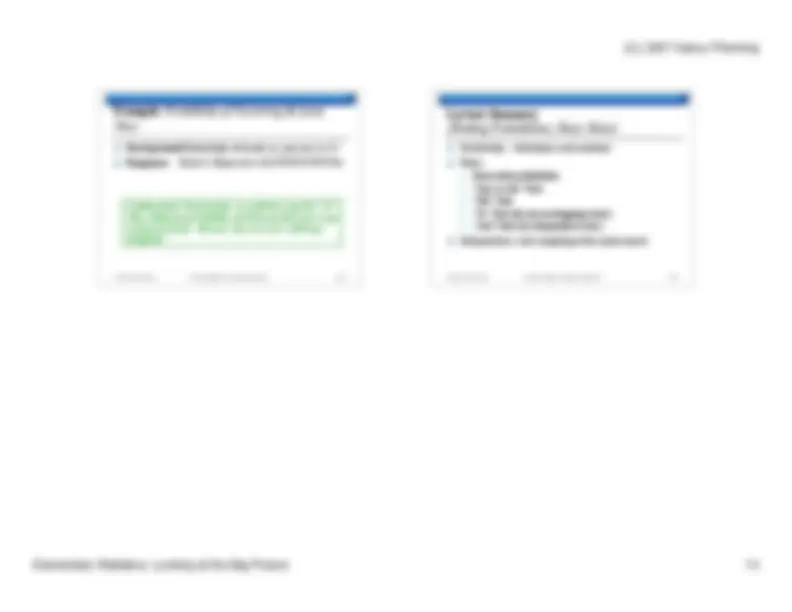









Study with the several resources on Docsity

Earn points by helping other students or get them with a premium plan


Prepare for your exams
Study with the several resources on Docsity

Earn points to download
Earn points by helping other students or get them with a premium plan
Community
Ask the community for help and clear up your study doubts
Discover the best universities in your country according to Docsity users
Free resources
Download our free guides on studying techniques, anxiety management strategies, and thesis advice from Docsity tutors
An excerpt from nancy pfenning's 'elementary statistics: looking at the big picture'. It covers the concepts of probability, its definitions, and various rules such as permissible probabilities, sum-to-one rule, not rule, and or rule for non-overlapping events. The document also discusses independent and and rules and their relation to independence and sampling with replacement.
Typology: Study notes
1 / 13

This page cannot be seen from the preview
Don't miss anything!








(C) 2007 Nancy Pfenning Elementary Statistics: Looking at the Big Picture
Probability: Definition and Notation Basic Rules Independence; Sampling With Replacement (C) 2007 Nancy Pfenning Elementary Statistics: Looking at the Big Picture L11. 2
4 Stages of Statistics Data Production (discussed in Lectures 1-4) Displaying and Summarizing (Lectures 5-12) Probability Finding Probabilities Random Variables Sampling Distributions Statistical Inference (C) 2007 Nancy Pfenning Elementary Statistics: Looking at the Big Picture L11. 3
Sample
1. PRODUCE DATA **2. SUMMARIZE
Statistics Science of producing, summarizing, drawing conclusions from data Summaries about sample data Probability Science dealing with random behavior Chance of happening
(C) 2007 Nancy Pfenning Elementary Statistics: Looking at the Big Picture L11. 6 Example: Ways to Determine a Probability Background : Some probability statements: Probability of randomly chosen card a heart is 0. Probability of randomly chosen student in a class getting A is 0.25, according to the professor. Probability of candidate being elected, according to an editorial, is 0.25. Question: Are these probabilities all determined in the same way? (C) 2007 Nancy Pfenning Elementary Statistics: Looking at the Big Picture L11. 7 Example: Ways to Determine a Probability Background : Some probability statements: Probability of randomly chosen card a heart is 0. Probability of randomly chosen student in a class getting A is 0.25, according to the professor Probability of candidate being elected, according to an editorial, is 0.25. Response: These three probabilities are determined in different ways… (C) 2007 Nancy Pfenning Elementary Statistics: Looking at the Big Picture L11. 8
Probability: chance of an event occurring, determined as the Proportion of equally likely outcomes comprising the event; or Proportion of outcomes observed in the long run that comprised the event; or Likelihood of occurring, assessed subjectively. (C) 2007 Nancy Pfenning Elementary Statistics: Looking at the Big Picture L11. 9 Example: Three Ways to Determine a Probability Background : Some probability statements:
(C) 2007 Nancy Pfenning Elementary Statistics: Looking at the Big Picture L11. 17
To stress how intuitive the basic rules are, we Begin with example for which we can intuit the solution. State general rule based on solution. Apply rule to solve a second example. Looking Ahead: This process will be used to establish all the rules needed to understand behavior of random variables in general, sampling distributions in particular, so we have theory needed to perform inference. (C) 2007 Nancy Pfenning Elementary Statistics: Looking at the Big Picture L6. 18 Example: Intuiting Permissible Probabilities Rule Background : A six-sided die is rolled once. Questions: What is the probability of getting a nine? What is the probability of getting a number less than nine? (C) 2007 Nancy Pfenning Elementary Statistics: Looking at the Big Picture L6. 20 Example: Intuiting Permissible Probabilities Rule Background : A six-sided die is rolled once. Responses: P(N)=__________________ P(L)=__________________ (C) 2007 Nancy Pfenning Elementary Statistics: Looking at the Big Picture L11. 21
The probability of an impossible event is 0, the probability of a certain event is 1, and all probabilities must be between 0 and 1.
(C) 2007 Nancy Pfenning Elementary Statistics: Looking at the Big Picture L6. 22 Example: Applying Permissible Probabilities Rule Background : Consider the values -1, -0.1, 0.1, 10. Question: Which of these are legitimate probabilities? (C) 2007 Nancy Pfenning Elementary Statistics: Looking at the Big Picture L6. 24 Example: Applying Permissible Probabilities Rule Background : Consider the values -1, -0.1, 0.1, 10. Response: (C) 2007 Nancy Pfenning Elementary Statistics: Looking at the Big Picture L11. 25
Background : Consider the roll of a six-sided die. Question: What do we get if we sum the probabilities of rolling a 1, a 2, a 3, a 4, a 5, and a 6? (C) 2007 Nancy Pfenning Elementary Statistics: Looking at the Big Picture L11. 27
Background : Consider the roll of a six-sided die. Response:
(C) 2007 Nancy Pfenning Elementary Statistics: Looking at the Big Picture L11. 34
Background : A statistics professor reports that the probability of a randomly chosen student getting an A is 0.25. Response: Looking Back: Alternatively, since A and not A are the only possibilities, according to the Sum-to-One Rule, we must have 0.25+P(not A)=1, so P(not A)=1-0.25=0.75. (C) 2007 Nancy Pfenning Elementary Statistics: Looking at the Big Picture L11. 35
For any event A, P(not A)=1-P(A). Or, we can write P(A)=1-P(not A). (C) 2007 Nancy Pfenning Elementary Statistics: Looking at the Big Picture L11. 36
Background : The probability of a randomly chosen American owning at least one TV set is 0.98. Question: What is the probability of not owning any TV set? (C) 2007 Nancy Pfenning Elementary Statistics: Looking at the Big Picture L11. 38
Background : The probability of a randomly chosen American owning at least one TV set is 0.98. Response: P(not TV)=
(C) 2007 Nancy Pfenning Elementary Statistics: Looking at the Big Picture L11. 39 Example: Intuiting Non-Overlapping “Or” Rule Background : A statistics professor reports that the probability of a randomly chosen student in her class getting an A is 0.25, and the probability of getting a B is 0.30. Question: What is the probability of getting an A or a B? (C) 2007 Nancy Pfenning Elementary Statistics: Looking at the Big Picture L11. 41 Example: Intuiting Non-Overlapping “Or” Rule Background : A statistics professor reports that the probability of a randomly chosen student in her class getting an A is 0.25, and the probability of getting a B is 0.30. Response: (C) 2007 Nancy Pfenning Elementary Statistics: Looking at the Big Picture L6. 42 Example: When Probabilities Can’t Simply be Added Background : A statistics professor reports that the probability of a randomly chosen student in her class getting an A is P(A)=0.25, and the probability of being a female is P(F)=0.60. Question: What is the probability of getting an A or being a female? (C) 2007 Nancy Pfenning Elementary Statistics: Looking at the Big Picture L6. 44 Example: When Probabilities Can’t Simply be Added Background : A statistics professor reports that the probability of a randomly chosen student in her class getting an A is P(A)=0.25, and the probability of being a female is P(F)=0.60. Response:
(C) 2007 Nancy Pfenning Elementary Statistics: Looking at the Big Picture L11. 50 Example: Intuiting Independent “And” Rule Background : A balanced coin is tossed twice. Question: What is the probability of both the first and the second toss resulting in tails? (C) 2007 Nancy Pfenning Elementary Statistics: Looking at the Big Picture L11. 52 Example: Intuiting Independent “And” Rule Background : A balanced coin is tossed twice. Response: Looking Back: Alternatively, since there are 4 equally likely outcomes HH, HT, TH, TT, we know each has probability ¼=0.25. (C) 2007 Nancy Pfenning Elementary Statistics: Looking at the Big Picture L6. 53 Example: When Probabilities Can’t Simply be Multiplied Background : In a child’s pocket are 2 quarters and 2 nickels. He randomly picks a coin, does not replace it, and picks another. Question: What is the probability of the first and the second coins both being quarters? (C) 2007 Nancy Pfenning Elementary Statistics: Looking at the Big Picture L6. 55 Example: When Probabilities Can’t Simply be Multiplied Background : In a child’s pocket are 2 quarters and 2 nickels. He randomly picks a coin, does not replace it, and picks another. Response:
(C) 2007 Nancy Pfenning Elementary Statistics: Looking at the Big Picture L11. 56
For some pairs of events, whether or not one occurs impacts the probability of the other occurring, and vice versa: the events are said to be dependent. If two events are independent , whether or not one occurs has no effect on the probability of the other occurring. (C) 2007 Nancy Pfenning Elementary Statistics: Looking at the Big Picture L11. 57
For any two independent events A and B, P(A and B)=P(A) × P(B). Note: The word “and” entails multiplication. (C) 2007 Nancy Pfenning Elementary Statistics: Looking at the Big Picture L11. 58
Sampling with replacement is associated with events being independent. Sampling without replacement is associated with events being dependent. (C) 2007 Nancy Pfenning Elementary Statistics: Looking at the Big Picture L11. 59 Example: Applying Independent “And” Rule Background : What is the probability of getting a female and then a male, if we pick… Questions: 2 people with replacement from a household where 3 of 5 (that is, 0.6) are female? 2 people without replacement from household where 3 of 5 (that is, 0.6) are female? 2 people without replacement from a large university where 0.6 are female?
(C) 2007 Nancy Pfenning Elementary Statistics: Looking at the Big Picture L6. 66 Example: Probability of Occurring At Least Once Background :Probability of heads in coin toss is 0.5. Response: P(A)=1-P(not A)=1-P(TTTTTTTTTT)= Looking Back: Theoretically, we could have used the “Or” Rule, adding the probabilities of all the possible ways to get at least one heads. However, there are over 1,000 ways altogether! (C) 2007 Nancy Pfenning Elementary Statistics: Looking at the Big Picture L6. 67 Lecture Summary (Finding Probabilities; Basic Rules) Probability: definitions and notation Rules Permissible probabilities “Sum-to-One” Rule “Not” Rule “Or” Rule (for non-overlapping events) “And” Rule (for independent events) Independence and sampling with replacement